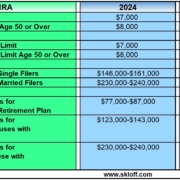Is There a Tax Benefit to Owning My Company’s Stock in My 401(k)?

Money Matters – Skloff Financial Group Question of the Month – May 1, 2022
Is There a Tax Benefit to Owning My Company’s Stock in My 401(k)?
By Aaron Skloff, AIF, CFA, MBA
Q: Between my own purchases and my company’s matches, I accumulated a large position of my company’s stock inside my 401(k). Is there a tax benefit now or in the future to owning my company’s stock in my 401(k)?
A: The Problem — Stock Concentration and Increased Risk Can Outweigh Tax Benefits
Many investors let the tax tail wag the investment dog. A high centration in a single stock reduces portfolio diversification, increases risk, but can offer a big tax benefit. A concentrated position in a single stock can lead to risk adjusted underperformance relative to overall markets, or even worse – huge losses (e.g.: Enron, Lehman Brothers, General Electric, J.C. Penney). Caution: The investment landscape is littered with poor investments that were pitched as great tax shelters. If the tax benefits written by Congress and enforced by the Internal Revenue Service (IRS) turn out be unfavorable or not favorable enough for Congress, Congress will simply change the tax code to its favor. Look no further than the SECURE Act for an egregious example of this.
The Solution — Net Unrealized Appreciation (NUA) Tax Benefits
Distributions from pre-tax retirement plans like 401(k)s are normally taxed as income in the year of the distribution. Internal Revenue Code (IRC) Section 402(e)(4), Net Unrealized Appreciation (NUA), provides a valuable tax benefit on distributions of your company stock from your 401(k). Specifically, you can avoid income taxes of up to 37% at the federal level on the gains on your company stock upon distribution. Instead, you can pay a much lower long-term capital gains rate, based on your income, as low as 0% or has high as 20% on the gains. There are three requirements to utilize NUA.
Are You Interested in Learning More?
Requirement 1 – Lump Sum Distribution. You must remove the entire account value within one taxable year.
Requirement 2 – Triggering Event. You must have at least one triggering event: death, reaching age 59 ½, separation from service or becoming disabled (as defined by IRC Section 72(m)(7)).
Requirement 3 – Triggering Event. You must transfer the company shares to a taxable account.
Taxation. Outright withdrawals from a pre-tax 401(k) are taxed as income, and subject to a 10% penalty if under age 59 ½. A properly completed NUA allows the non-company stock portion of a 401(k) to be rolled over to an IRA (IRA Rollover) or another retirement plan and the company stock proportion to a taxable investment account. The IRA Rollover or rollover to another retirement plan portion is not taxed until withdrawn. The cost basis of your company stock portion transferred to your taxable account is taxed as income at your income tax rate. Upon selling the company stock (e.g.: a week later or 10 years later) the gain is subject to your long term capital gain rate.
Tax Benefit. The difference in tax rates on the gain in your company stock using NUA versus not using NUA can be 37% (37% income tax rate – 0% long-term capital gains rate = 37%). That is a 37% tax arbitrage. The offset is the cost basis of the company stock transferred to your taxable account is taxed as income in the year it is transferred. If an NUA 0is completed in a lower income year or upon retirement, your income tax rate may be lower than it would be otherwise.
NUA Example. After working at your company for 10 years and contributing 20% of your salary and bonuses to your company stock in your 401(k), those contributions, including employer matches, total $80,000. Despite underperforming major indexes and the other investments in your 401(k), your company stock increased in value to $100,000 – generating a 4.0% annual return or 25% cumulative return. Your 80% of contributions and matches in other investments that total $320,000 increased in value to $560,000 – generating a 10.0% annual return or 75% cumulative return. The lesson here is to not let the tax tail wag the investment dog by concentrating your investments in your company stock solely for the tax benefits of NUA. In this example, the company stock increased by 25%, while the other investments increased by 75%.
Upon leaving your company or reaching age 59 ½ (both triggering events), you complete a lump sum distribution by transferring your company stock into your investment account and your other investments into your IRA Rollover account. The $80,000 of company stock is taxed as income immediately, while the increase will be taxed as a long term capital gain upon the sale (e.g.: in a day or in 30 years). Withdrawals from the IRA Rollover are taxed as income in the year they are taken. Triggering events, such as a job transition, often occur in lower income years when your income is lower and your tax rate is lower.
Action Step — Evaluate Your Taxes and Use NUA in Moderation
Let the investment tax tail wag the investment dog. Do not let the tax tail wag the investment dog. Limit your portfolio concentration in any one stock to increase risk adjusted performance relative to overall markets. Work closely with your Registered Investment Adviser (RIA) to evaluate your company stock, current and projected future income tax rate and capital gains rate to determine if NUA is the right strategy for you.
Aaron Skloff, Accredited Investment Fiduciary (AIF), Chartered Financial Analyst (CFA), Master of Business Administration (MBA) is CEO of Skloff Financial Group, a Registered Investment Advisory firm specializing in financial planning, investment management and benefits for small to middle sized companies. He can be contacted at www.skloff.com or 908-464-3060.













